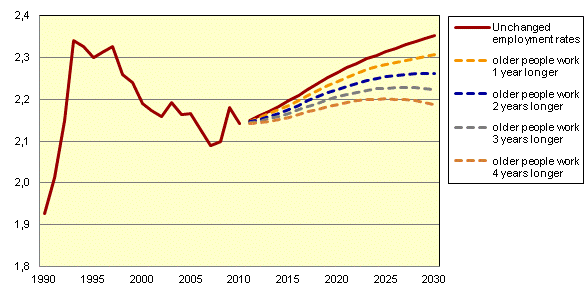Employment 2030 – Can the current dependency burden be maintained?:
Older people and foreign born persons increasingly important for employment
Statistical news from Statistics Sweden 2012-06-27 9.30
To maintain the same dependency burden as today in 2030, almost 600 000 more people will have to be employed. The percentage of the population who work will have to increase in several labour market groups to achieve this. Higher employment rates among older people and foreign born persons would have the greatest effect on future employment.
If the percentage of the population aged 16–74 in gainful employment – the employment rate – remains on the same level as it is today, employment is expected to increase by almost 140 000 people by 2030. Since the total population is increasing at a faster rate, this will lead to the dependency burden (the total population/the employed population aged 16–74 years) rising from 2.14 in 2010 to 2.35 in 2030. Every gainfully employed person will hence have to “provide for” 2.35 persons including themselves in 2030 compared to 2.14 persons in 2010. For the dependency burden to develop at a slower rate, more people will have to work.
Future employment and the dependency burden will be affected if, for example, older people, young people, foreign born persons and women work more in the future. How large this effect will be on each group is presented in the report Employment in 2030 – can the current dependency burden be maintained?.
Every additional year that older people work means an extra 80–90 000 persons in employment
If elderly people carry on working longer than they do today, the employment rate will increase noticeably in the future. For every additional year they work, employment will increase by between 80 000 and 90 000 people by 2030. If older people work four years longer, there will be a total increase in employment of 480 000 persons by 2030. Despite such a marked upward age shift on the labour market, the dependency burden will nevertheless increase slightly by 2030.
Forecast from 2011 for scenarios where older people are assumed to work longer and a scenario where employment rates remain unchanged

Source : RAMS (Register-based labour market statistics), Statistics Sweden and the Forecast Institute, Statistics Sweden (for the forecast). Note: Time series breaks in 1993 and 2004.
Employment among foreign born persons is of substantial significance
Foreign born persons will become increasingly important for employment in the future as they are expected to make up the entire increase in the working-age population up until 2030. The employment rate among foreign born persons is currently much lower than it is among native born persons. If foreign born employment rates come 50 percent closer to those of native born persons, it is estimated that employment among 16–74 year-olds will increase by 330 000 persons by 2030. If the difference is reduced by as much as 75 percent, employment will increase by 430 000 persons. But not even in this case will the number of employed persons increase enough to maintain the dependency burden at its current level.
The fact that younger people are starting to work earlier and that women are working to a greater extent than today has much less effect on the future dependency burden.
Employment needs to increase for several groups simultaneously
To maintain the dependency burden at the current level, employment will have to increase in several population groups at the same time. One example could be if older people work three years longer, young people start working one year earlier in combination with employment rates among the foreign born population coming 50 percent closer to those among the native born population. In such a scenario, employment would increase by just over 600 000 persons by 2030, which would in fact lead to an expected dependency burden that will be slightly under the current level.
Definitions and explanations
Statistics Sweden’s latest population forecast from 2012 forms the basis of the employment population projections. This forecast predicts the expected size and composition of the population up to 2030.
When describing the dependency burden trend in the various scenarios, the 2010 dependency burden is used as a reference. The model is based on the development up to 2030 without any fluctuations in the business cycle.
Publication
Feel free to use the facts from this statistical news but remember to state Source: Statistics Sweden.
